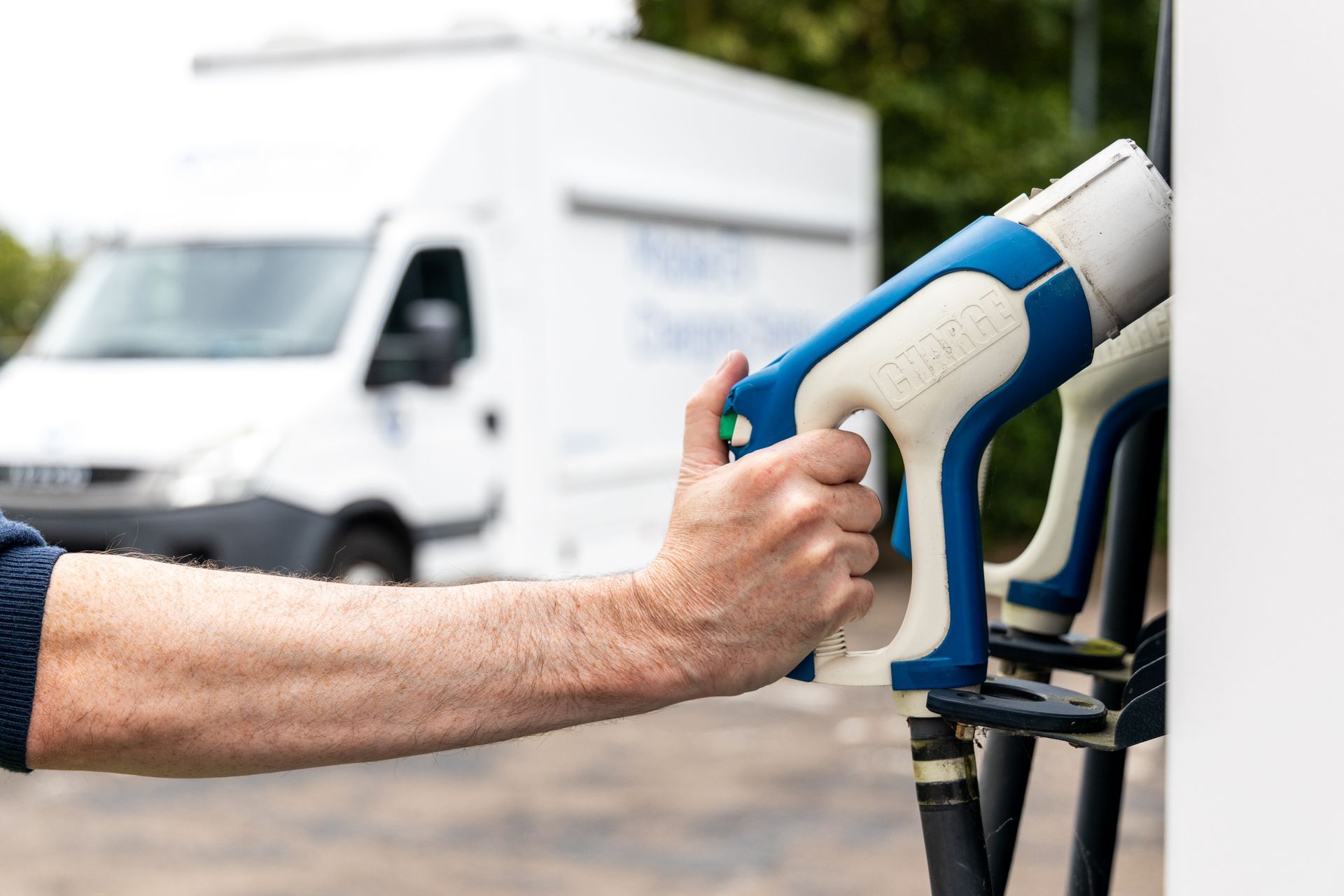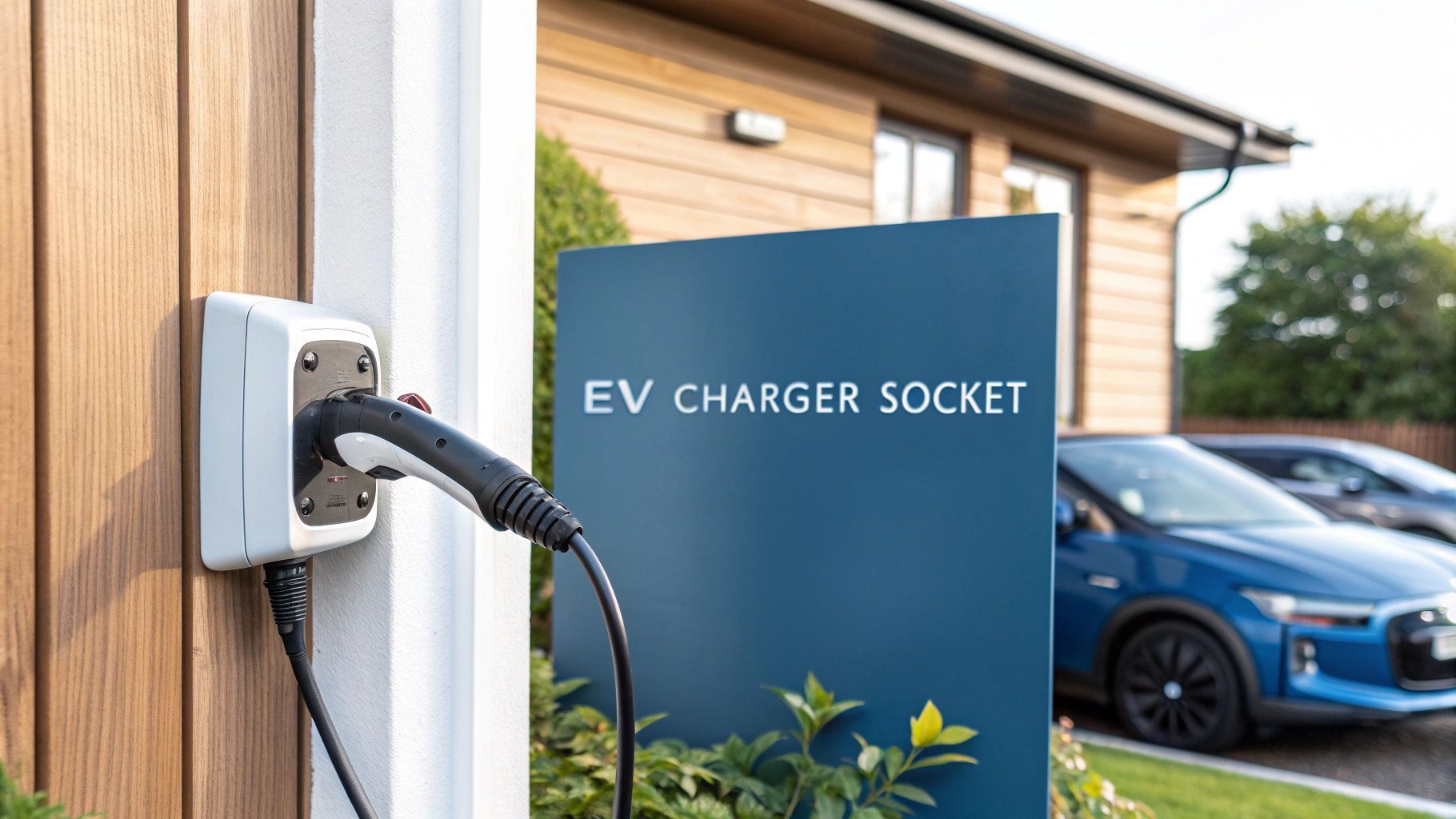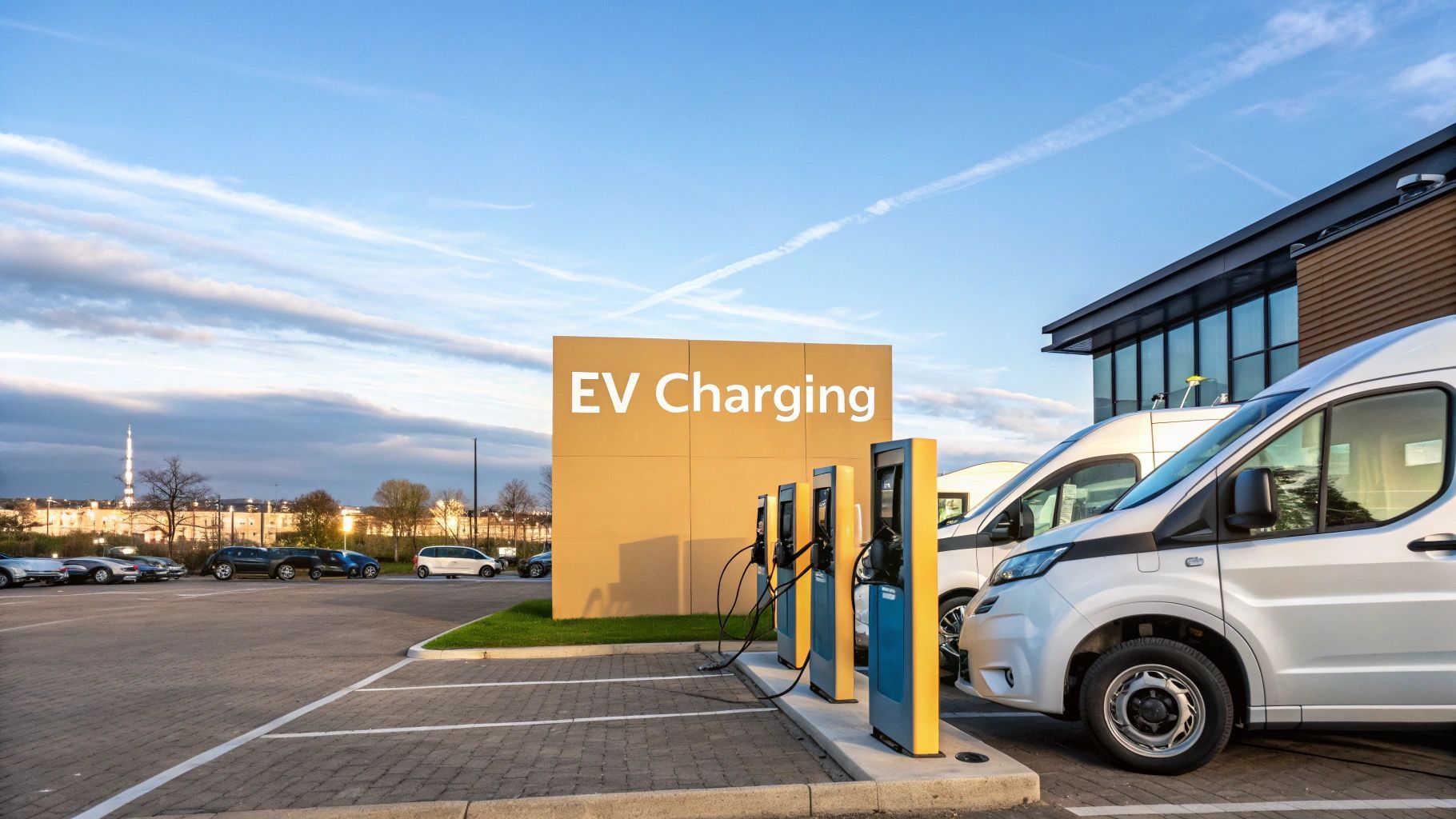Workplace EV Charging Stations: Your Profit Guide
The big switch to electric vehicles is changing the daily commute all over Britain, and it’s turning workplace EV charging stations from a nice-to-have perk into a core business strategy. For companies, this is a fantastic opportunity to open up new revenue streams, right from their own car parks. Installing chargers is no longer just about being green; it's a genuinely smart financial decision, especially when leveraging flexible solutions like mobile charging.
Why Your Car Park Is an Untapped Asset
That company car park, once just a static cost on the balance sheet, actually holds a huge amount of potential. As more of your employees, clients, and visitors start driving electric cars, the need for convenient charging is skyrocketing.
By meeting this demand, you’re not just offering a helpful service—you're creating a brand-new income stream for your business. It also positions your company as a forward-thinking, sustainable leader, which is a massive draw for attracting and keeping top talent in today's competitive market.
This guide is your roadmap to cashing in on the electric transition. We’ll walk through how to monetise your car park and turn it into a reliable source of revenue, focusing on practical steps like using mobile charging and payment systems to make transactions simple and maximise your profits from day one.
Turning Space into Profit
The real financial opportunity is in generating direct income every time someone charges their car. Instead of giving away power for free, the modern approach is to set a competitive price per kilowatt-hour. This model doesn’t just cover your electricity and maintenance costs; it allows you to secure a healthy profit margin.
Think of it like a vending machine in your break room. You provide a service people need, and you generate revenue with every single use. The key advantages are clear:
- Direct Revenue: You earn money from every charging session, whether it's from employees, visitors, or even the general public if you open it up.
- Increased Property Value: A commercial property kitted out with modern EV charging infrastructure is far more appealing to potential tenants and buyers.
- Enhanced Brand Image: Showing a real commitment to sustainability boosts your public perception and strengthens your corporate responsibility profile.
The Growing Demand for Workplace Charging
The move to electric vehicles isn't just a passing trend; it's a government-backed national shift. The UK's infrastructure is expanding at pace to support this change. Take the Workplace Charging Scheme (WCS), for example, which has funded the installation of 63,777 charging sockets in workplace car parks as of July 2025. This government support makes it clear just how big the need—and the opportunity—is for businesses like yours. You can dig into the full statistics on the official government website.
By installing EV chargers, you are future-proofing your business. You’re meeting a very real, present-day need while getting ready for a future where the vast majority of cars on the road will be electric. That kind of foresight creates a lasting competitive advantage.
Ultimately, the goal is to transform your car park into a self-sufficient, income-generating part of your business. To get a deeper understanding of this potential, you might be interested in our guide on how to enhance your car park business with modern solutions.
Choosing the Right Chargers for Your Business
Picking the right hardware is the bedrock of a successful workplace charging setup. With so many different charging speeds and technologies out there, it’s vital to match the equipment to how your car park will actually be used. Get this wrong, and you could end up with frustrated drivers and missed revenue.
Think of charging an EV like filling a water tank. Some chargers are like a small hose, filling the tank slowly over many hours. Others are like a high-pressure fire hose, getting the job done in minutes. Each has its place, and understanding this difference is the first step to designing a system that works.
Understanding Charger Speeds
The speed of a charger is measured in kilowatts (kW). A higher kW rating means faster charging, but it also comes with higher costs for both the hardware and the installation. Your business will likely need a mix of chargers to serve employees, visitors, and maybe even a commercial fleet—each with different needs.
There are three main speeds to get your head around:
-
Slow AC Chargers (3-7kW): These are the most common and cost-effective options, perfect for employees who are parked for a full workday. A 7kW charger can add around 25-30 miles of range per hour , which is ideal for a top-up during office hours. They're the "small hose" in our analogy—slow, steady, and great for long-stay parking.
-
Fast AC Chargers (22kW): Offering a big step up in speed, these chargers are a brilliant middle ground. A 22kW unit can deliver roughly 70-80 miles of range in an hour . This makes it a great fit for visitors on-site for a few hours or for company fleet vehicles that need a quicker turnaround.
-
Rapid DC Chargers (50kW+): These are the "fire hoses" of the EV world. They deliver direct current (DC) power straight to the battery for incredibly fast charging. Capable of adding over 100 miles of range in just 20-30 minutes , they’re best suited for public charging hubs or businesses with high-turnover fleets that can’t afford downtime.
The Power of Smart and Mobile Charging
Beyond pure speed, the single most important feature for any modern workplace charging network is smart charging capability . A "dumb" charger just pushes out power whenever a car is plugged in. That might sound simple, but it can lead to massive energy bills and even overload your building's electrical system.
Smart chargers, on the other hand, are connected to the internet and can be controlled remotely. This isn't just a nice-to-have feature; it’s non-negotiable for running a profitable and efficient operation. An even more agile approach is mobile charging , where portable power banks deliver the charge. This eliminates installation costs, planning permission hurdles, and expensive grid upgrades entirely, allowing businesses to start generating revenue immediately.
Smart and mobile charging allows you to manage energy use intelligently, schedule charging for off-peak hours when electricity is cheapest, and balance the electrical load. This helps you avoid costly infrastructure work and keeps your running costs low, directly boosting your bottom line.
These systems also gather crucial data on usage patterns, energy consumption, and revenue. This information is vital for setting the right price, understanding demand, and planning for future expansion. Without it, you’re flying blind. To make sure the chargers you pick will serve the widest range of vehicles, learning more about EV charging compatibility can help you make an even more informed decision.
Building Your EV Charging Business Case
Once you’ve got the right hardware in mind, the next job is to build a solid financial case for your investment. This isn’t just about covering costs; it’s about turning your car park into a profitable asset. The key is to stop seeing EV charging as a simple staff perk and start viewing it as a powerful new revenue stream.
With the right strategy, your chargers can quickly pay for themselves and start generating consistent, reliable income. The secret is a flexible and user-friendly mobile payment system. This lets you monetise every charging session effortlessly while keeping total control over your pricing, turning your car park into an instant profit centre.
Unlocking Direct Revenue Streams
The most straightforward way to bring in money is to set a tariff for every kilowatt-hour (kWh) of electricity used. This model ensures you cover your energy costs, maintenance, and software fees—and, most importantly, secure a healthy profit margin on top.
A mobile payment system is the engine that drives this profitability. It allows you to set up different pricing structures with ease, catering to different user groups and maximising your earnings throughout the day.
- Employee Tariffs: You could offer your team a subsidised rate as a valuable perk, encouraging them to go electric while still covering your costs.
- Visitor and Public Tariffs: For everyone else, you can set a competitive market rate. This turns your car park into a public charging destination, attracting new customers to your premises.
- Dynamic Pricing: This is a more advanced strategy where you adjust prices based on demand. You can increase the tariff during peak hours to maximise profit and lower it during quieter periods to encourage more use.
A study found that public EV charging networks have an average uptime of just over 73% . By making sure your chargers are reliable and easy to pay for via an app, you position your site as a premium, trustworthy location that drivers will actively seek out and return to.
Comparing Different Business Models
Choosing the right way to monetise your chargers really depends on your business goals. Are you focused on employee benefits, maximising public revenue, or finding a balance? Each approach has its own advantages. For businesses looking for guidance, exploring options for finance for EV chargers can provide a clearer path to profitability.
To help you decide, let's look at the most common revenue models for workplace charging.
Revenue Models for Workplace EV Chargers
Here’s a breakdown of the most common approaches to help you decide which strategy fits your business best.
| Revenue Model | Description | Best For | Potential Profit |
|---|---|---|---|
| Staff Perk (Subsidised) | Employees charge at a reduced rate or for free, with the cost absorbed by the company as a benefit. | Businesses focused on talent attraction, retention, and corporate sustainability goals. | Low to None (Cost Centre) |
| Cost Recovery | The price per kWh is set to cover only electricity, hardware, and maintenance costs. | Companies wanting to offer a charging facility without it affecting their bottom line. | Neutral (Breakeven) |
| Blended Model | Staff receive a subsidised rate while visitors and the public pay a higher, market-competitive tariff. | Most businesses, as it balances employee perks with a strong revenue opportunity. | Medium to High |
| Fully Commercial Model | All users, including staff, pay a full commercial rate designed to maximise profit. | High-traffic locations like retail parks, hotels, or city-centre offices. | High |
Ultimately, the model you choose will shape how your investment performs, turning a potential cost into a genuine commercial opportunity.
Quantifying the Indirect Financial Wins
Beyond the direct income from charging sessions, installing workplace EV charging stations delivers some serious indirect financial benefits. These advantages might not always show up as a line item on a profit-and-loss statement, but they contribute directly to a stronger, more resilient business.
First off, properties equipped with modern EV charging infrastructure are simply more attractive to prospective tenants and buyers. They often command higher rental yields and sale prices because it signals a building is modern, well-maintained, and ready for the future.
Furthermore, offering workplace charging is a powerful tool for employee retention. In a competitive job market, it's a tangible benefit that can persuade top talent to join—and stay. Given how much it costs to replace an employee, any investment that boosts retention is a financially sound one.
Your Practical Installation Roadmap
So, you've got a solid business case. Now, how do you turn that into a fully operational network of workplace EV charging stations ? This is where the rubber meets the road. We need a clear, practical plan that cuts through the jargon and gets you from concept to a live system. Every successful project starts with a deep understanding of your own site’s unique quirks.
The first and most critical step is getting a professional site survey done. This isn't just about pointing to a corner of the car park. It's a proper deep dive into your property’s electrical guts, parking layout, and even the ground conditions. An expert will size up your current electrical capacity to see if it can handle new fixed chargers or if you'll need an upgrade.
They’ll also pinpoint the best spots for the chargers themselves, finding that sweet spot between visibility, accessibility, and proximity to your power supply. However, with mobile charging solutions , this entire step becomes simpler, as no groundworks or fixed electrical connections are required.
Navigating the Installation Process
With the site assessment in hand, it's time to pick your partners and sort out the necessary approvals. This is the moment your plan starts to feel real, moving from paper to a tangible asset for your business.
Choosing a certified installer is non-negotiable for fixed units. Look for an OZEV (Office for Zero Emission Vehicles) authorised installer, as this is your ticket to accessing government grants. A good installer does more than just bolt the hardware to the wall; they'll guide you through the maze of planning permission and grid connection applications if you need them.
The good news is that for most installations, planning permission isn't an issue as it often falls under 'permitted development'. However, if your site is in a conservation area, on a listed building, or the project requires some serious digging, you absolutely must talk to your local authority first. Again, mobile charging bypasses these complexities entirely.
Securing Funding and Managing the Project
One of the biggest perks for UK businesses is the government support on offer for fixed charge points. The Workplace Charging Scheme (WCS) is a voucher-based scheme that can seriously soften the initial financial blow.
The WCS provides support towards the upfront costs of the purchase and installation of electric vehicle chargepoints, offering up to £350 per socket for a maximum of 40 sockets across all sites for each applicant. This can result in savings of up to £14,000 , making the business case for installation even more compelling.
Applying for the WCS is a straightforward online job, but you must do it before any installation work kicks off. Once you have a quote from an OZEV-approved installer, you can fill out the application. If you’re successful, you'll get a voucher to hand over to your installer, who then knocks that amount off your final bill.
To help you see how all these pieces fit together, this flow chart breaks down the core steps for getting your workplace EV charging up and running.
As you can see, a successful project is built on that initial foundation of careful assessment, followed by methodical procurement and expert commissioning.
The final piece of the puzzle is managing the project timeline and budget. You'll want to work closely with your installer to set clear milestones for the groundwork, electrical work, hardware installation, and the final commissioning. It’s also a smart move to build in a small contingency fund—around 10% of the total project cost —to cover any curveballs without derailing your budget. This kind of proactive management is key to a smooth, efficient installation.
The UK's public charging infrastructure has exploded in recent years, and this growth has massively influenced workplace networks. By January 2024, POD Point had really pulled ahead of the pack, providing over three times more workplace charging points than the next biggest network, ChargePlace Scotland. You can dig into more data on the UK's leading workplace charging networks on Statista.
Maximising Your Long-Term Charging Success
With your workplace EV charging stations installed and ready to go, the job shifts from construction to smart operation. The real measure of success isn’t launch day; it’s how well the system performs in the months and years that follow. The goal is simple: create a seamless, reliable, and profitable charging experience that keeps drivers happy.
This means thinking less like an installer and more like an operator. Long-term success comes down to setting clear rules, staying on top of maintenance, and using data to make good decisions. If you manage your new infrastructure proactively, you’ll ensure it delivers real value to your business, your staff, and your customers every single day.
Establishing Clear Usage Policies
The first step to smooth sailing is setting clear expectations for everyone. A simple, well-defined usage policy prevents confusion and makes sure everyone gets fair access, which is vital as demand inevitably grows. This policy should be shared with all staff and displayed clearly near the charging bays.
Think about including these key points:
- Pricing Structure: Be upfront about the cost per kWh. Will staff get a subsidised rate while the public pays a standard tariff? Transparency here builds trust.
- Time Limits and Idle Fees: Nobody likes a charger hog. Set rules to stop fully charged cars from blocking the bays. An idle fee, which kicks in after a short grace period, is a great way to encourage people to move their vehicles.
- Access Rules: Define who can use the chargers and when. Perhaps they’re for staff only during office hours but open to the public on evenings and weekends.
This basic framework helps manage traffic, keeps your chargers available, and ultimately boosts their ability to generate revenue.
Proactive Maintenance and Monitoring
A broken charger is worse than no charger at all. It chips away at your reputation for reliability. A straightforward, proactive maintenance schedule is the best way to keep your stations online and working. This isn't about creating complex procedures; it's about catching small issues before they become big, expensive problems.
Start with daily visual checks. A quick walk-around can spot obvious problems like damaged cables, blocked bays, or screens that aren't working. This gives you an immediate heads-up to take action.
Beyond the daily once-over, it’s smart to partner with a qualified technician for regular inspections. They’ll ensure your hardware and software are running as they should.
A proactive maintenance plan, combining daily visual checks with professional servicing, is the secret to high uptime. This focus on reliability ensures a positive user experience and protects the long-term profitability of your investment.
Modern smart charging software is your best friend here. It lets you monitor every charger from your desk, giving you real-time data on uptime, usage, and revenue. If a unit goes offline or flags an error, you'll know instantly—often before a driver even realises there’s an issue.
Marketing and Future-Proofing Your Investment
Don't just build it and hope they come. You need to let EV drivers know you’re there. Getting your chargers listed on popular public charging maps like Zapmap , PlugShare , and Google Maps is a must. This one simple step puts your business on the radar of thousands of potential customers in your area.
Shout about your workplace EV charging stations on your company website and social media, too. It’s a brilliant marketing tool that shows you’re committed to sustainability—a huge plus for attracting eco-conscious customers and top talent.
Finally, let the data from your charging software guide your next steps. Are your chargers always busy? Are they packed at certain times of day? This information is gold when you’re deciding when and where to expand your network.
The market for EV charging is only going one way. Projections show the UK market is estimated at 64,360 units in 2025 and is expected to grow at a compound annual rate of 21.32% to reach 169,150 units by 2030. You can dig into the full analysis in Mordor Intelligence's industry report. Staying ahead of that curve is how you ensure your investment pays off for years to come.
Unpacking the Practicalities of Workplace EV Charging
Even with a solid plan, you're bound to have questions about the nuts and bolts of installing and running EV chargers at your workplace. Let's tackle some of the most common queries we hear from UK businesses, giving you the straightforward answers you need to move forward with confidence.
What's the Real Cost of Installation?
This is the big question, and the honest answer is: it depends. The final figure hinges on the type and number of chargers you want, plus the unique layout of your site. For a fixed charger, a standard 7kW AC unit might land somewhere between £1,000–£1,500 per socket after you’ve factored in grant funding.
That price can creep up, though. If your site needs significant electrical upgrades or if there's a lot of groundwork involved, costs will naturally be higher. In contrast, mobile charging solutions avoid these capital costs entirely. You can start with a flexible leasing or subscription model, eliminating the large upfront investment and making it much easier to scale up as demand grows.
Can We Actually Make Money from This?
Absolutely. In fact, turning a profit is one of the biggest reasons businesses are installing modern workplace EV charging stations . With a simple mobile payment system in place, you can set a price per kilowatt-hour (kWh) that covers your electricity and running costs, with a healthy margin on top. That's the foundation of a great commercial model.
Once you open your chargers to the public, you create an entirely new, reliable revenue stream. With mobile charging, this is even more direct as you bypass the costs of installation, maintenance, and grid upgrades, meaning more of the revenue goes straight to your bottom line.
By setting competitive tariffs for visitors and the public—while maybe offering a nice subsidised rate for your staff—you can transform a car park from a cost centre into a valuable commercial asset. In busy areas, this can become a surprisingly lucrative part of your business.
Do We Need Planning Permission?
More often than not, you won't need to go through the full planning permission process for fixed chargers. In the UK, installing EV charge points is usually considered 'permitted development'. This generally applies to wall-mounted units or charging posts that are under a certain height, typically around 2.3 metres .
But there are some important exceptions. You'll almost certainly need to seek permission if your building is listed, sits within a conservation area, or if the installation requires major construction or groundwork.
This is a major advantage of mobile charging : as there is no permanent installation, planning permission is not required at all. You can deploy your charging service instantly without any bureaucratic delays.
What Is the Workplace Charging Scheme?
The Workplace Charging Scheme (WCS) is a brilliant UK government grant set up to help businesses, charities, and public sector organisations with the upfront cost of getting fixed chargers installed. It’s a voucher-based system that seriously cuts down your initial investment.
Here are the key things you need to know:
- The Funding: The grant gives you up to £350 per charging socket .
- The Limit: You can claim for a maximum of 40 sockets , bringing the potential total to a hefty £14,000 .
- Who's Eligible?: Your organisation needs to have dedicated off-street parking, be based in England, Wales, Scotland, or Northern Ireland, and either own the property or have the landlord's permission to install.
The application is all done online via the OZEV portal. If you're approved, you get a unique voucher code. You just pass this code to your OZEV-authorised installer, and they'll claim the grant for you once the job is done, taking the value right off your final bill. Simple as that.
Ready to turn your car park into a profitable asset? At ZAPME , we specialise in cutting-edge mobile EV charging solutions that can get you started without the need for complex fixed installations. Alternatively our parent www.zpnenergy.com can provide fixed installations. Explore our flexible options and see how we can help your business today. Discover your solution at ZAPME.











